Abstract
Simian virus 40 (SV40) transcription complexes were labeled in cells with 3-min pulses of [3H]uridine 48 h after infection and were extracted from nuclei in isotonic buffer or in a buffer containing Sarkosyl. In sucrose gradients, the labeled complexes sedimented faster than both free RNA and most SV40 nucleoproteins. Most of the pulse-labeled nascent RNA hybridized to the entire late region of SV40, remained bound to viral DNA in Cs2SO4 gradients, and ranged in size from a few nucleotides to about 5,000 nucleotides, with a peak at about 700. In contrast, the SV40-associated RNA polymerase activity in the same preparations sedimented near the major peak of SV40 nucleoproteins and was clearly separated from the transcription complexes bearing pulse-labeled nascent RNA. The two kinds of transcription complexes were released from isolated nuclei at different rates. Complexes bearing pulse-labeled RNA were released immediately when the nuclei were agitated in a Dounce homogenizer in isotonic buffer, whereas most of the complexes bearing RNA polymerase active in vitro were released more slowly, during subsequent incubation of the nuclei at 0°C. Since the complexes bearing pulse-labeled nascent RNA were virtually inactive in vitro, the blocked complexes described by Laub et al. (Proc. Natl. Acad. Sci. U.S.A. 77:3297-3301, 1980) probably account for almost all the SV40-associated RNA polymerase activity studied previously by many investigators. New procedures must be developed to preserve the activity of the pulse-labeled complexes if the many advantages of the SV40 system for studying transcription by nucleoprotein complexes in vitro are to be realized fully.
Full text
PDF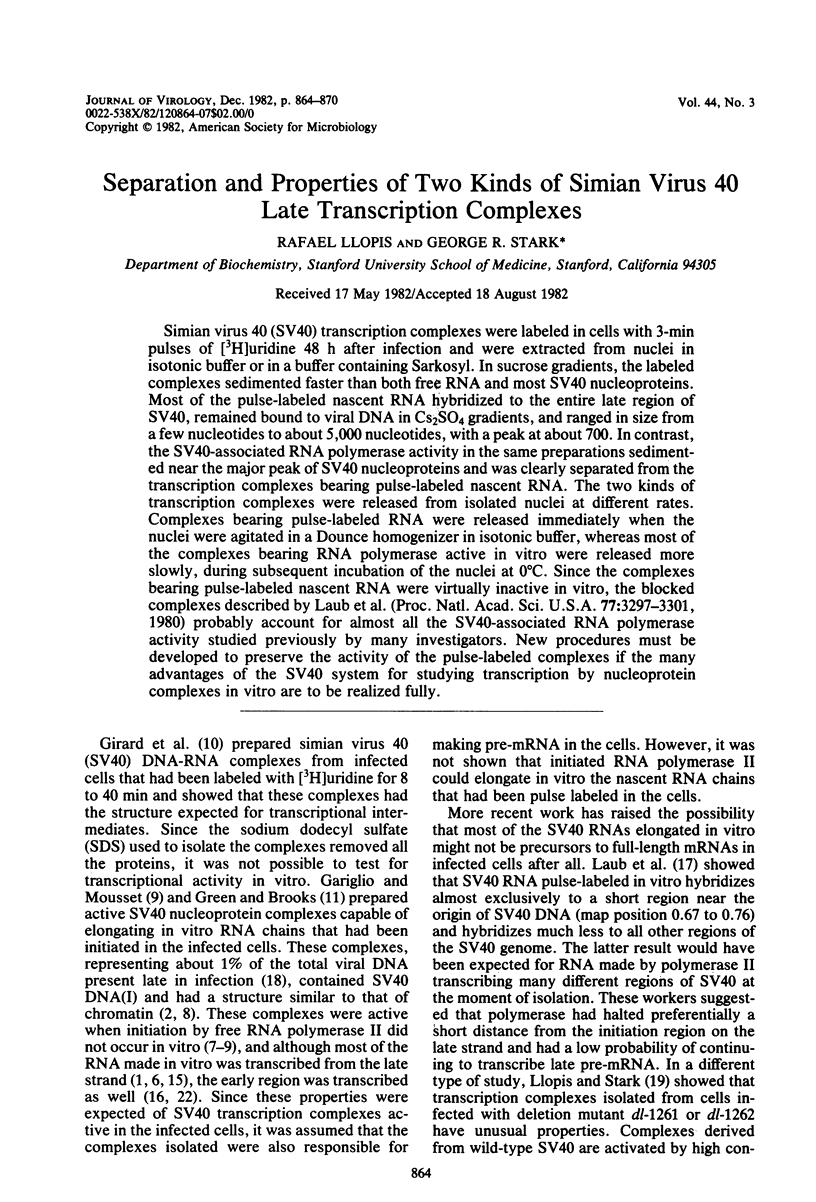
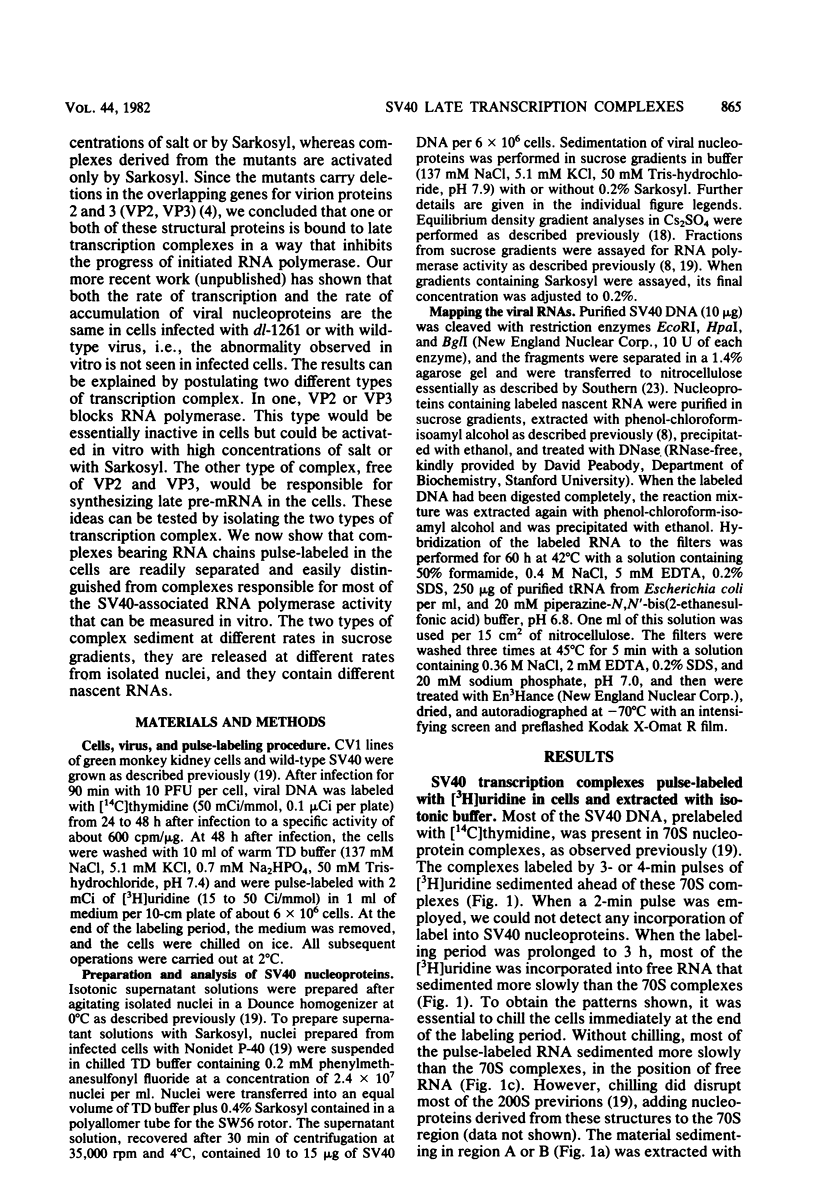
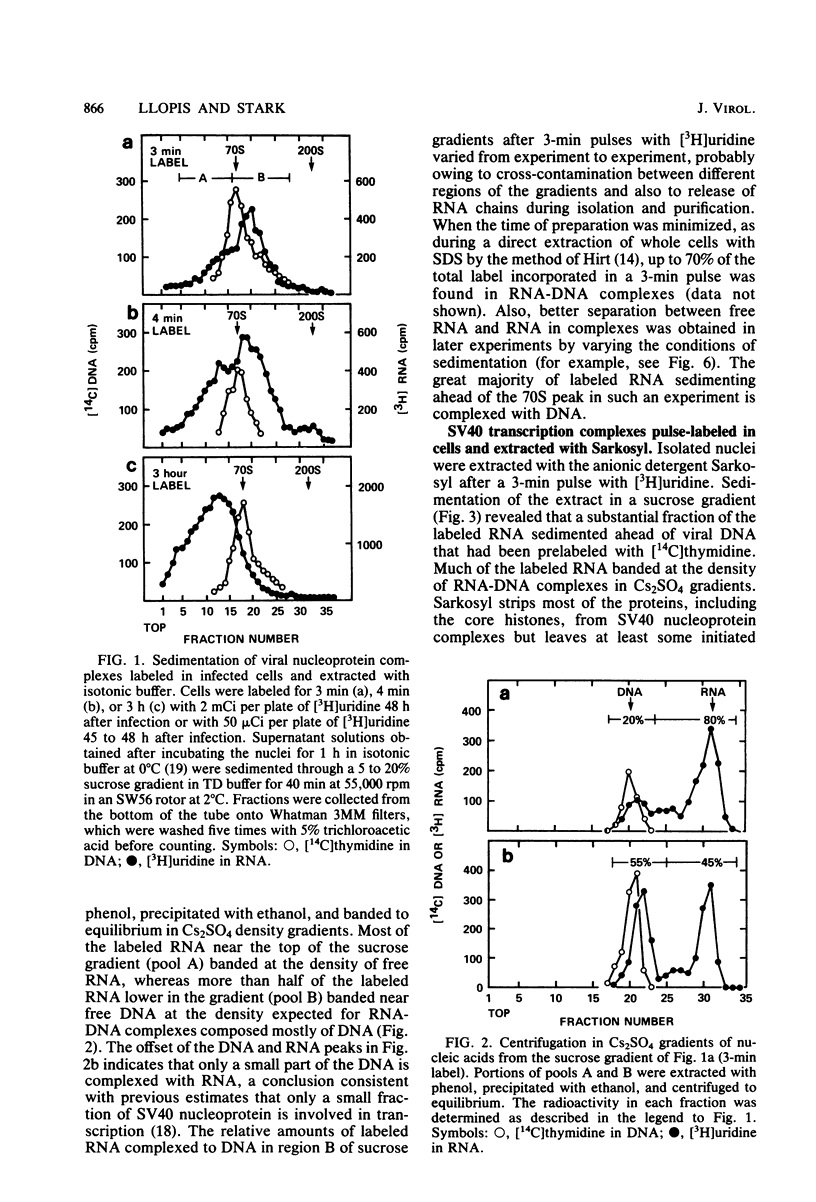
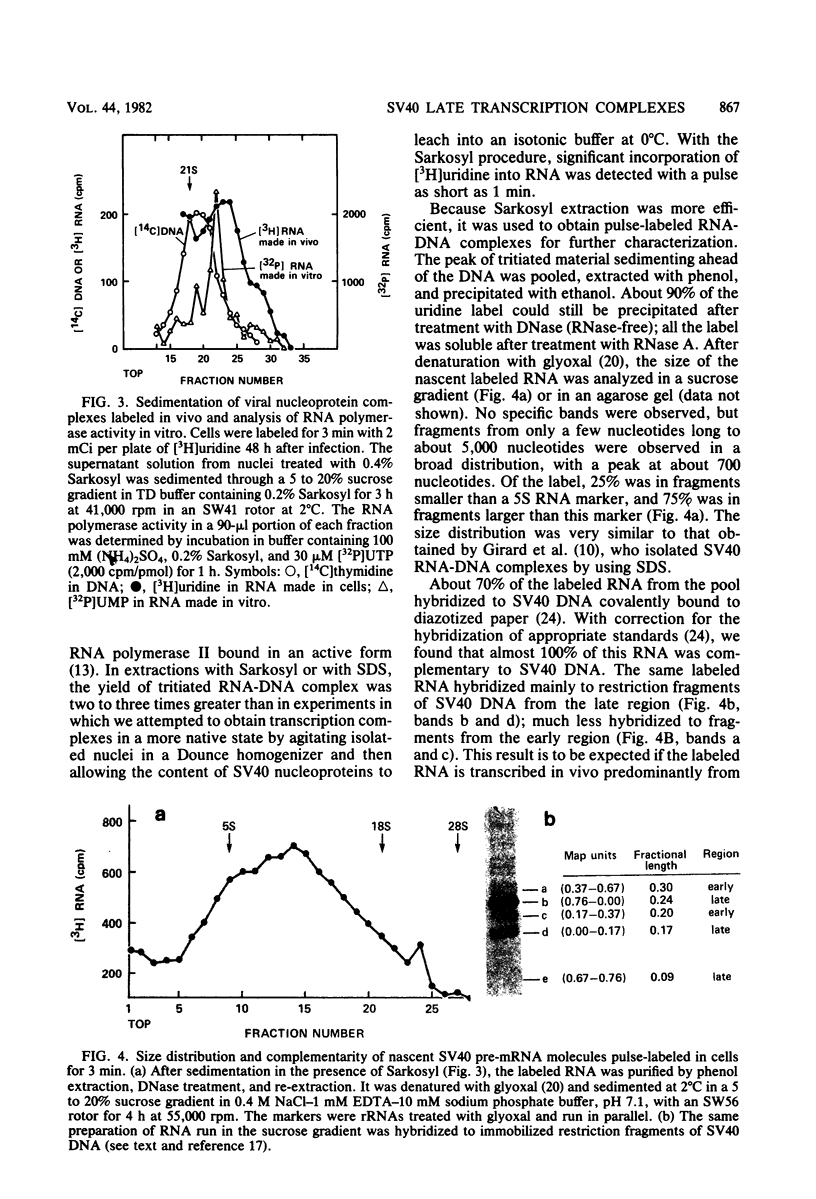
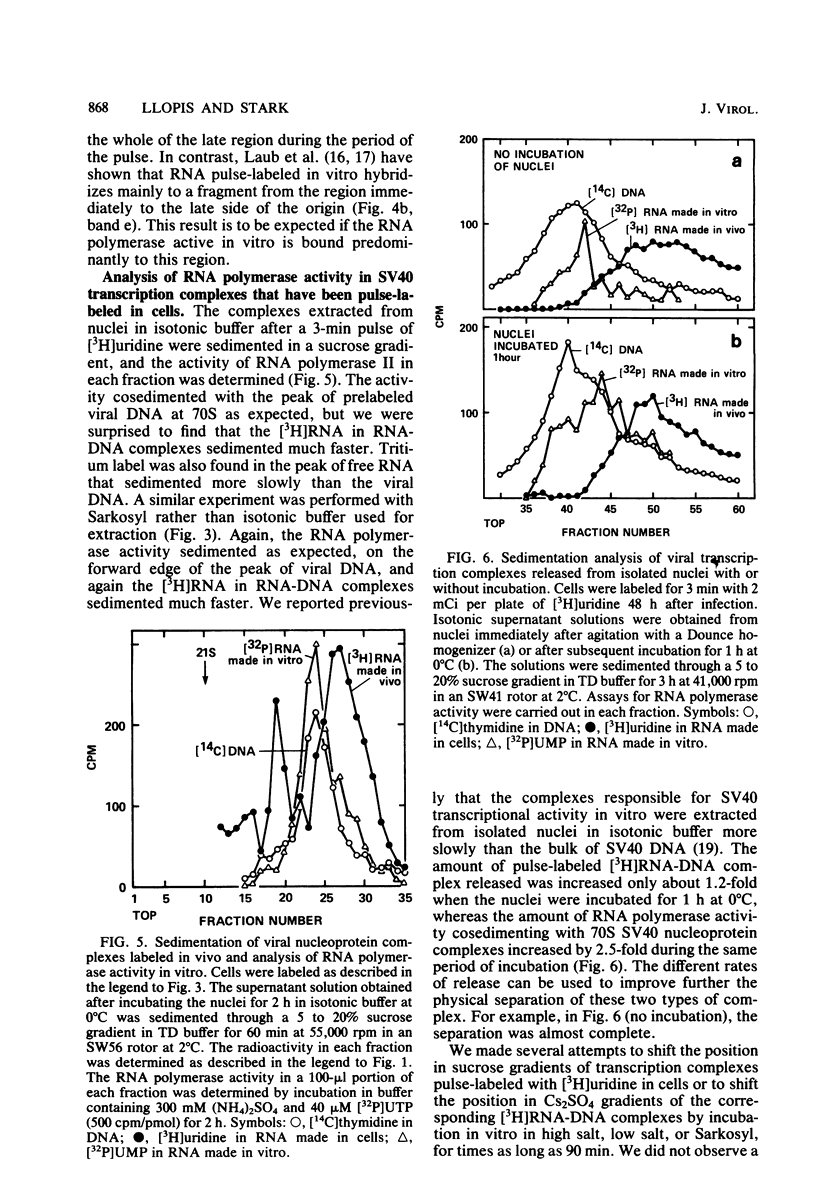
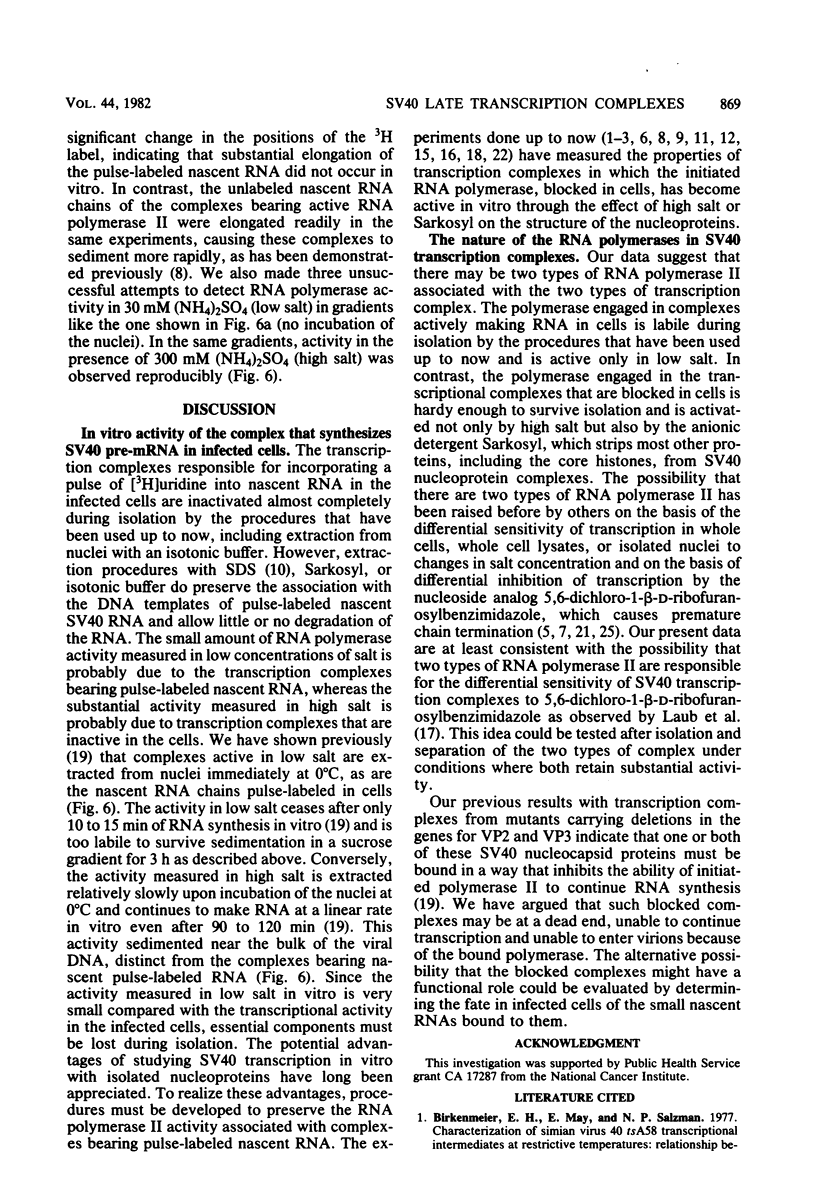
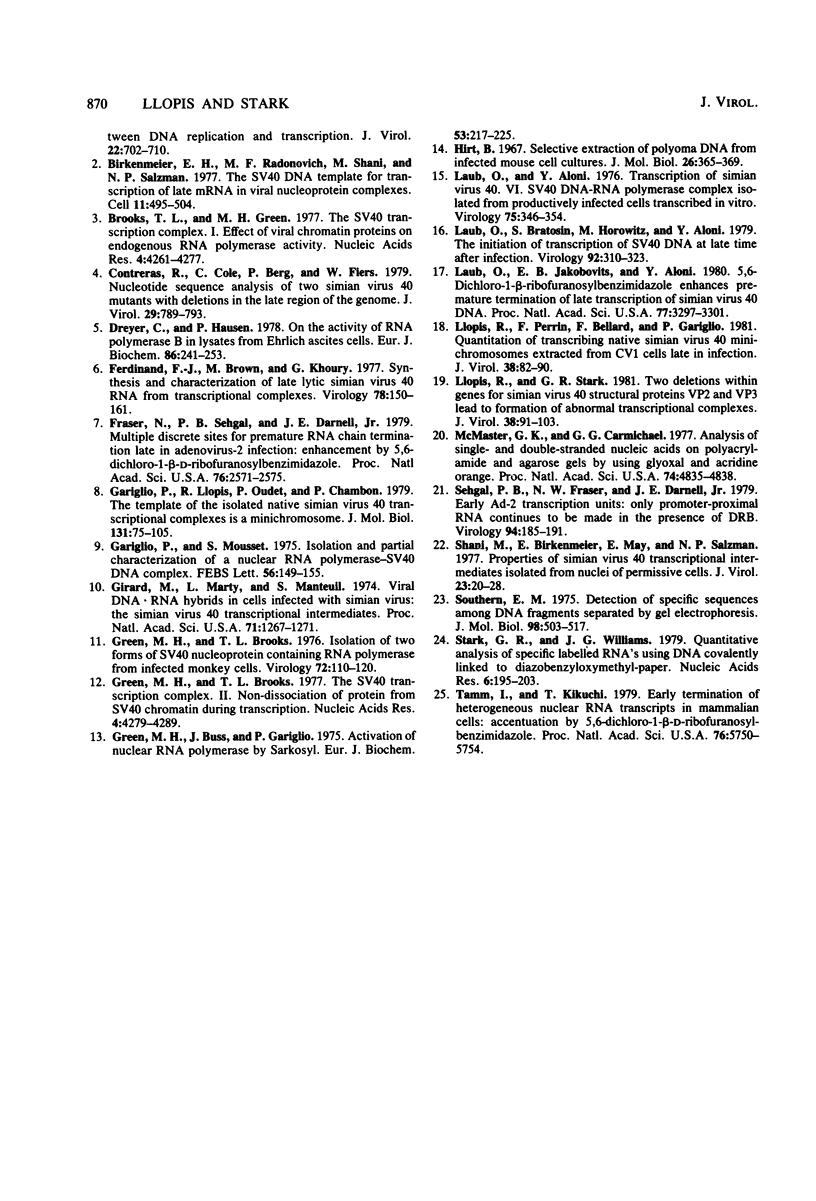
Images in this article
Selected References
These references are in PubMed. This may not be the complete list of references from this article.
- Birkenmeier E. H., Radonovich M. F., Shani M., Salzman N. P. The SV40 DNA template for transcription of late mRNA in viral nucleoprotein complexes. Cell. 1977 Jul;11(3):495–504. doi: 10.1016/0092-8674(77)90067-8. [DOI] [PubMed] [Google Scholar]
- Brooks T. L., Green M. H. The sv40 transcription complex. I. Effect of viral chromatin proteins on endogenous RNA polymerase activity. Nucleic Acids Res. 1977 Dec;4(12):4261–4277. doi: 10.1093/nar/4.12.4261. [DOI] [PMC free article] [PubMed] [Google Scholar]
- Contreras R., Cole C., Berg P., Fiers W. Nucleotide sequence analysis of two simian virus 40 mutants with deletions in the late region of the genome. J Virol. 1979 Feb;29(2):789–793. doi: 10.1128/jvi.29.2.789-793.1979. [DOI] [PMC free article] [PubMed] [Google Scholar]
- Dreyer C., Hausen P. On the activity of RNA polymerase B in lysates from Ehrlich ascites cells. Eur J Biochem. 1978 May;86(1):241–253. doi: 10.1111/j.1432-1033.1978.tb12305.x. [DOI] [PubMed] [Google Scholar]
- Ferdinand F. J., Brown M., Khoury G. Synthesis and characterization of late lytic simian virus 40 RNA from transcriptional complexes. Virology. 1977 May 1;78(1):150–161. doi: 10.1016/0042-6822(77)90087-3. [DOI] [PubMed] [Google Scholar]
- Fraser N. W., Sehgal P. B., Darnell J. E., Jr Multiple discrete sites for premature RNA chain termination late in adenovirus-2 infection: enhancement by 5,6-dichloro-1-beta-D-ribofuranosylbenzimidazole. Proc Natl Acad Sci U S A. 1979 Jun;76(6):2571–2575. doi: 10.1073/pnas.76.6.2571. [DOI] [PMC free article] [PubMed] [Google Scholar]
- Gariglio P., Llopis R., Oudet P., Chambon P. The template of the isolated native simian virus 40 transcriptional complexes is a minichromosome. J Mol Biol. 1979 Jun 15;131(1):75–105. doi: 10.1016/0022-2836(79)90302-4. [DOI] [PubMed] [Google Scholar]
- Gariglio P., Mousset S. Isolation and partial characterization of a nuclear RNA polymerase - SV40 DNA complex. FEBS Lett. 1975 Aug 1;56(1):149–155. doi: 10.1016/0014-5793(75)80130-x. [DOI] [PubMed] [Google Scholar]
- Girard M., Marty L., Manteuil S. Viral DNA-RNA hybrids in cells infected with simian virus: the simian virus 40 transcriptional intermediates. Proc Natl Acad Sci U S A. 1974 Apr;71(4):1267–1271. doi: 10.1073/pnas.71.4.1267. [DOI] [PMC free article] [PubMed] [Google Scholar]
- Green M. H., Brooks T. L. Isolation of two forms of SV40 nucleoprotein containing RNA polymerase from infected monkey cells. Virology. 1976 Jul 1;72(1):110–120. doi: 10.1016/0042-6822(76)90316-0. [DOI] [PubMed] [Google Scholar]
- Green M. H., Brooks T. L. The sv40 transcription complex. II. Non-dissociation of protein from SV40 chromatin during transcription. Nucleic Acids Res. 1977 Dec;4(12):4279–4289. doi: 10.1093/nar/4.12.4279. [DOI] [PMC free article] [PubMed] [Google Scholar]
- Hirt B. Selective extraction of polyoma DNA from infected mouse cell cultures. J Mol Biol. 1967 Jun 14;26(2):365–369. doi: 10.1016/0022-2836(67)90307-5. [DOI] [PubMed] [Google Scholar]
- Laub O., Aloni Y. Transcription of simian virus 40. VI. SV 40 DNA-RNA polymerase complex isolated from productively infected cells transcribed in vitro. Virology. 1976 Dec;75(2):346–354. doi: 10.1016/0042-6822(76)90033-7. [DOI] [PubMed] [Google Scholar]
- Laub O., Bratosin S., Horowitz M., Aloni Y. The initiation of transcription of SV40 DNA at late time after infection. Virology. 1979 Jan 30;92(2):310–323. doi: 10.1016/0042-6822(79)90136-3. [DOI] [PubMed] [Google Scholar]
- Laub O., Jakobovits E. B., Aloni Y. 5,6-dichloro-1-beta-ribofuranosylbenzimidazole enhances premature termination of late transcription of simian virus 40 DNA. Proc Natl Acad Sci U S A. 1980 Jun;77(6):3297–3301. doi: 10.1073/pnas.77.6.3297. [DOI] [PMC free article] [PubMed] [Google Scholar]
- Llopis R., Perrin F., Bellard F., Gariglio P. Quantitation of transcribing native simian virus 40 minichromosomes extracted from CV1 cells late in infection. J Virol. 1981 Apr;38(1):82–90. doi: 10.1128/jvi.38.1.82-90.1981. [DOI] [PMC free article] [PubMed] [Google Scholar]
- Llopis R., Stark G. R. Two deletions within genes for simian virus 40 structural proteins VP2 and VP3 lead to formation of abnormal transcriptional complexes. J Virol. 1981 Apr;38(1):91–103. doi: 10.1128/jvi.38.1.91-103.1981. [DOI] [PMC free article] [PubMed] [Google Scholar]
- McMaster G. K., Carmichael G. G. Analysis of single- and double-stranded nucleic acids on polyacrylamide and agarose gels by using glyoxal and acridine orange. Proc Natl Acad Sci U S A. 1977 Nov;74(11):4835–4838. doi: 10.1073/pnas.74.11.4835. [DOI] [PMC free article] [PubMed] [Google Scholar]
- Sehgal P. B., Fraser N. W., Darnell J. E., Jr Early Ad-2 transcription units: only promoter-proximal RNA continues to be made in the presence of DRB. Virology. 1979 Apr 15;94(1):185–191. doi: 10.1016/0042-6822(79)90448-3. [DOI] [PubMed] [Google Scholar]
- Shani M., Birkenmeier E., May E., Salzman N. P. Properties of simian virus 40 transcriptional intermediates isolated from nuclei of permissive cells. J Virol. 1977 Jul;23(1):20–28. doi: 10.1128/jvi.23.1.20-28.1977. [DOI] [PMC free article] [PubMed] [Google Scholar]
- Southern E. M. Detection of specific sequences among DNA fragments separated by gel electrophoresis. J Mol Biol. 1975 Nov 5;98(3):503–517. doi: 10.1016/s0022-2836(75)80083-0. [DOI] [PubMed] [Google Scholar]
- Stark G. R., Williams J. G. Quantitative analysis of specific labelled RNA'S using DNA covalently linked to diazobenzyloxymethyl-paper. Nucleic Acids Res. 1979 Jan;6(1):195–203. doi: 10.1093/nar/6.1.195. [DOI] [PMC free article] [PubMed] [Google Scholar]
- Tamm I., Kikuchi T. Early termination of heterogeneous nuclear RNA transcripts in mammalian cells: accentuation by 5,6-dichloro 1-beta-D-ribofuranosylbenzimidazole. Proc Natl Acad Sci U S A. 1979 Nov;76(11):5750–5754. doi: 10.1073/pnas.76.11.5750. [DOI] [PMC free article] [PubMed] [Google Scholar]



